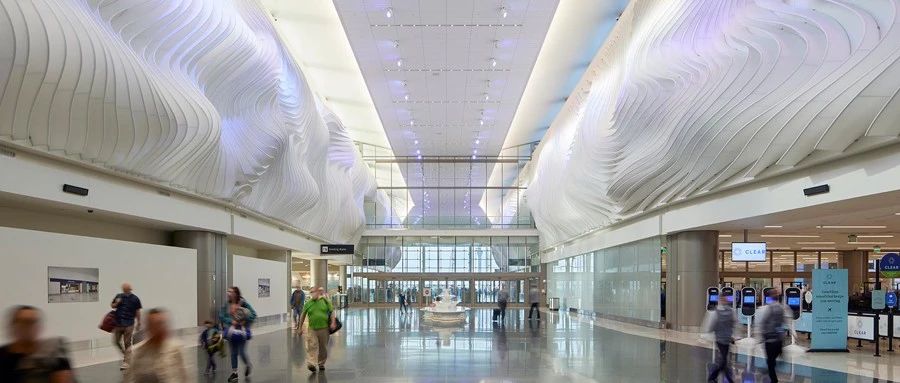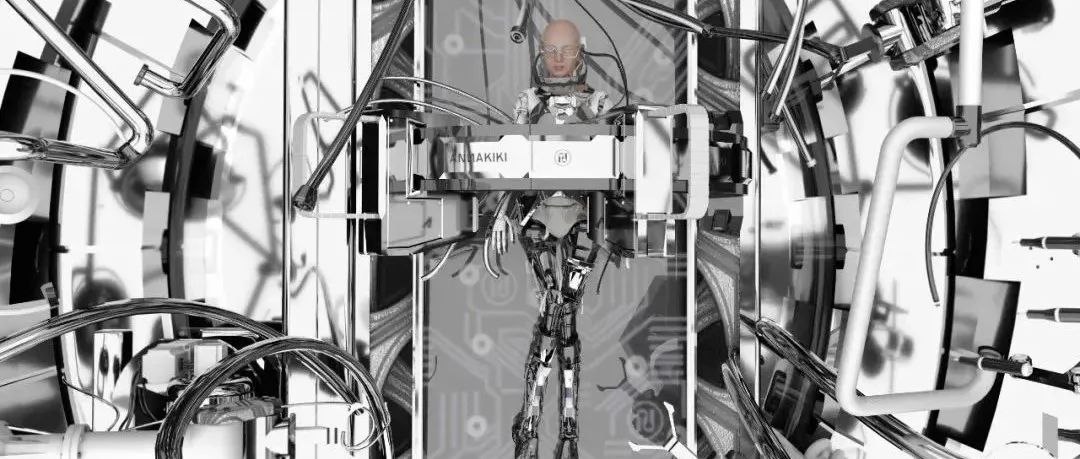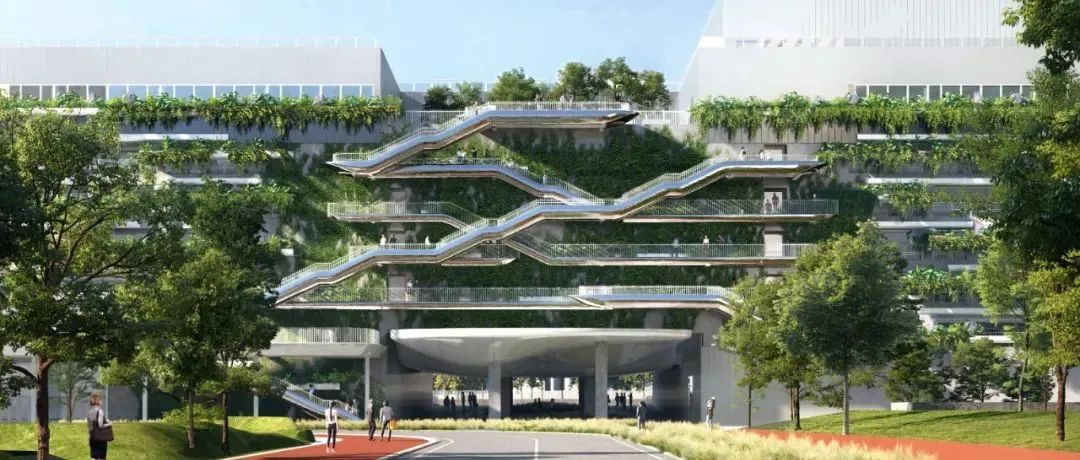经过二十年的规划和六年的施工,新盐湖城国际机场于2020年年底启用,在同一地点用耗资41 亿美元的先进设施取代了三个老化的1950和1960年代的航站楼和大厅。这是犹他州历史上最大的公共工程项目,也是21世纪美国第一个新建枢纽机场。
机场提供一个灵活且规模适当的设施,以实现更高效、可持续的未来,同时保持具有竞争力的成本。其它愿景目标包括建造一座能够经受住重大地震的机场,并且能够从内到外体现犹他州的美丽。
HOK航空+交通设计组总监Matt Needham在新闻发布会上发表讲话,宣布盐湖城国际机场获得LEED金牌认证。(照片由盐湖城国际机场提供)| HOK Aviation + Transportation Director Matt Needham speaks at the news conference announcing the airport’s LEED Gold certification (photo courtesy of Salt Lake City International Airport).
美国绿色建筑委员会(U.S. Green Building Council)宣布,新机场已达成航站楼和B大厅西区的LEED金牌认证目标。“作为美国最大的两个获得LEED v2009金级认证机场航站楼项目,机场团队面临着独特的挑战,即优先考虑健康和可持续性的同时还要在预定时间内完成大规模建设,”USGBC技术服务总监Lisa Stanley说。“我知道这项任务有多么艰巨,并需要多少预先规划才能使这项工程达到今天的水平。我们向所有相关人员表示祝贺。”
机场通过减排、废物最小化、节水和使用可再生能源,取得了这一认证。实践可持续性从施工第一天开始。在机场启用之前,95%的建筑垃圾从垃圾填埋场和焚烧炉转移。开航前,航空公司开始从柴油转向电动地面支持设备。新机场的布局对其可持续性也起着重要作用。线性大厅布局减少了飞机空转和滑行的时间。
盐湖城机场部执行董事Bill Wyatt表示:“我们认识到减少碳排放对缓解全球气候变化的重要性。在可持续发展方面,我们社区钟爱的前机场效率低下。从锅炉系统到管道和电气系统,一切都无法修复。令人赞叹的是,新机场的水电使用量比前机场少很多。”
盐湖城市长Erin Mendenhall在新闻发布会上说:“取得LEED认证并不令人惊讶,因为我们的团队为确保今天能够站在这里庆祝而奋斗了近十年。然而,实现这一目标并非易事。以平方英尺衡量,这座设施是美国西部最大的获得LEED金级认证机场航站楼。”
项目信息
LEED新建工程类金级认证 (航站楼和B大厅西区)
地点:美国 犹他州 盐湖城
规模:241,550平方米
服务:建筑设计、工程、体验设计、室内设计、景观设计、灯光设计、规划 + 城市设计、可持续发展设计
奖项:注册商业投资会员协会犹他分会 – 年度最佳转型发展类项目
盐湖城国际机场一期包括一座新的90.9万平方英尺(约85,000平方米)的中央航站楼以及包含3,700英尺(约 1,128米)长的A大厅和,3400英尺(约1,036米)长的B大厅等两个线性大厅的西区部分,总共有45个登机口。一条近1000英尺(约305米)长的客运隧道连接着各个大厅。
“[我们] 正在改变机场的整个物理模型,” 执行董事Bill Wyatt说, “新航站楼对于飞机和乘客来说都更高效......简单来说它是一个美丽又非常实用的建筑。”
HOK的设计彰显了犹他州的自然美景和作为户外游憩中心的美誉。充斥自然光线的航站楼有着15米高的落地玻璃墙,可透进日光,同时提供了面向机场和附近瓦萨奇山脉的广阔视野。大地色调、自然衍生的内部和外部饰面,进一步将乘客与盐湖城独特的西部地域特色联系起来。新餐饮和商业设施也确保机场成为犹他州整体体验的延伸。HOK 体验设计团队设计的品牌和寻路系统表达了该地区的冒险精神,同时帮助旅客在机场中辨认方向。
一个巍峨的内部中庭——“峡谷”——跨越一个足球场的长度,并设有安检区、购物区和餐饮设施。艺术家Gordon Huether创作了一个 由 520 多个张力膜“鳍”组成的110米长的波浪形雕塑。这些由“鳍”构成的墙壁设计反映了犹他州引人注目的红色岩石峡谷、高山山峰和流动的水。
改善乘客体验的其他功能包括:
-
迎宾室——一个可容纳多达 400 人的大区域,包括一个壁炉——不再需要采取社交距离措施时,朋友和家人可以在那里迎接旅客。
-
滑雪场等设施有助于巩固该地区作为户外旅游目的地的地位。
-
16 条高科技安检通道将为旅客提速 30%。
-
一个新的 3,600 个车位的停车库提供两倍多的停车位,并使用基于摄像头的传感器系统来指示空位。旅客可以在车库直接托运行李。
-
整个机场的每个座位和的开放式座位区都有电插座。
-
拥有一个 2,600 平方米的达美航空全球最大的飞凡贵宾室;新的南航站楼是达美第四大枢纽的所在地。
可持续设计策略通过高性能玻璃、采光、节能机械和照明系统,以及航站楼和登机口位置的有效配置,减少燃料使用和飞机排放,最大限度地减少机场对环境的影响。
预计将于 2024 年完成的项目二期将包括拆除现有结构并建造南大厅的东部。由于新冠疫情,全球航空旅行急剧放缓,使团队能够将新机场的完工时间提前两年,可能节省高达 3 亿美元。新机场每年将能够接待三千四百万名乘客,使盐湖城成为一个越来越受欢迎的旅游和商业目的地,并促进经济增长。
Salt Lake City Airport Celebrates LEED Gold Certification on First Anniversary
One year ago, Salt Lake City International Airport opened the New SLC-Phase 1 as the first new U.S. hub airport built in the 21st century. The new airport provides a flexible, right-sized facility for a more efficient, sustainable future while maintaining competitive costs. Additional goals included building an airport that could withstand a major seismic event and reflect the beauty of Utah—both inside and out.
The U.S. Green Building Council announced that the new airport has achieved its goal of LEED Gold certification for both the Terminal Redevelopment Program project and Concourse B-West.
“As two of the largest LEED v2009 Gold-certified airport terminal projects in the United States, the airport team faced the unique challenge of building on a large scale while staying on task and prioritizing health and sustainability,” said Lisa Stanley, director of technical services at the USGBC. “I know just how daunting this task was and how much pre-planning was required to bring this project to where it is today, and congratulate all those involved.”
The airport achieved this certification through efforts involving emission reduction, waste minimization, water conservation and renewable energy implementation. Practicing sustainability began the first day of construction. Prior to the airport opening, 95 percent of construction waste was diverted from landfills and incinerators. Before opening day, the airlines began to transition from diesel to electric ground support equipment. The layout of the new airport also plays a substantial role in its sustainability. The linear concourse configuration reduces aircraft idling and taxi times.
“The airport recognizes the importance of reducing carbon emissions to mitigate our impact on global climate change,” said Bill Wyatt, executive director, Salt Lake City Department of Airports. “The former airport—which was a beloved part of our community—was inefficient when it came to sustainability efforts. Everything from the boiler system to the plumbing and electrical systems were beyond repair. What is really impressive is that the new airport uses less water and less electricity than the former facility.”
“This isn’t a surprise because our teams have been working intentionally for about a decade on making sure we could be standing here today celebrating this,” said Salt Lake City Mayor Erin Mendenhall at the Sept. 15 press conference. “Achieving this, though, isn’t a small feat. This facility is the largest LEED Gold certified airport terminal in the western United States, as measured by square footage.”
Project Facts
LEED-NC Gold (Terminal Redevelopment Program and Concourse B-West)
Location: Salt Lake City, Utah
Size: 2.6 million sq. ft. / 241,550 sq. m.
Services: Architecture, Engineering, Experience Design, Interiors, Landscape Architecture, Lighting Design, Planning + Urban Design, Sustainable Design
Awards: CCIM Utah – Transformative Development of the Year
After two decades of planning and six years of construction, the new Salt Lake City International Airport opened in 2020 to replace three aging, 1950s and 1960s terminals and concourses with a state-of-the-art, $4.1 billion facility on the same site. It’s the largest public works project in Utah’s history and the first new U.S. hub airport in the 21st century.
The first phase includes a new 909,000-sq.-ft. central terminal building and the west portions of two linear concourses—the 3,700-foot-long Concourse A and the 3,400-foot-long Concourse B—with a total of 45 new gates. A nearly 1,000-foot long passenger tunnel links the concourses.
“[We’re] changing the entire physical model of the airport,” said Executive Director Bill Wyatt. “The new terminal is “so much more efficient for aircraft and passengers…it’s just a stunningly beautiful and functional facility.”
HOK’s design celebrates Utah’s natural beauty and reputation as an outdoor recreation hub. The light-filled terminal has 50-foot floor-to-ceiling glass walls that draw in daylight while providing expansive views to the airfield and the nearby Wasatch Mountains. Earth-toned, naturally derived interior and exterior finishes further connect passengers to Salt Lake City’s unique western locale. New dining and retail options ensure that the airport is an extension of the overall Utah experience. Branding and wayfinding systems by HOK’s Experience Design team express the region’s adventurous spirit while helping travelers navigate through the airport.
A soaring interior atrium—“The Canyon”—spans the length of a football field and houses security screening areas, shopping, and food and beverage outlets. Artist Gordon Huether created a 362-foot-long, wavy sculpture made of more than 520 tensile membrane ‘fins’ that define the walls, with the design reflecting Utah’s dramatic red rock canyons, alpine peaks and moving water.
Other features that improve the passenger experience include:
-
The Greeting Room—a large area that can accommodate up to 400 individuals and that includes a fireplace—where friends and family members can pick up passengers after physical distancing measures are no longer in place.
-
Amenities like a ski drop help reinforce the region as a destination for outdoor tourism.
-
16 high-tech security screening lanes will be up to 30 percent faster for travelers.
-
A new 3,600-stall parking garage offers twice the number of spaces and uses a camera-based sensor system to indicate open spots. Passengers can check bags in garage kiosks.
-
Electronic plug-ins at each seat and in open seating areas throughout the airport.
-
A 28,000-sq.-ft. Delta Sky Club that is the carrier’s largest in the world; the new South terminal is home to Delta’s fourth-largest hub.
The project has achieved LEED Gold certification. Sustainable design strategies minimize the airport’s environmental footprint through high-performance glazing, daylighting, energy-efficient mechanical and lighting systems, and an efficient configuration of terminal and gate locations that reduces fuel use and aircraft emissions.
The second phase, expected to be complete in 2024, will include demolishing existing structures and building out the east portion of the South concourse. The dramatic global slowdown in air travel due to the COVID-19 pandemic has enabled the team to accelerate the new airport’s completion by two years, potentially saving up to $300 million.
The new airport will be able to handle 34 million passengers per year, positioning Salt Lake City for economic growth as an increasingly popular destination for tourism and business.
HOK是一家全球性设计、建筑、工程和规划公司。通过遍布全球的23间办公室网络,HOK以创新而卓越的设计方案创造丰富的人文空间,与客户携手成功.
HOK is a global design, architecture, engineering and planning firm. Through a network of 23 offices worldwide, HOK provides design excellence and innovation to create places that enrich people's lives and help clients succeed.
长按二维码关注我们的微信公众号
Click and hold the QR code to follow HOK
本文来自微信公众号“HOK贺克”(ID:hok_ap)。大作社经授权转载,该文观点仅代表作者本人,大作社平台仅提供信息存储空间服务。












